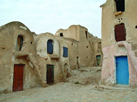How Has History Affected the People of North Africa?
Who Are the People of North Africa?, What Is North Africa Like Today?
On the map, find the countries of Western Sahara, Morocco, Algeria, Tunisia, Libya, and Egypt. These six countries make up North Africa. This small region lies between the Sahara Desert in the south and the Mediterranean Sea. The Sahara Desert takes up most of the land. The only good farmland runs along the coastline.
Now locate the Nile River. About 12,000 years ago, hunter-gatherers moved into the Nile River Valley. Hunter-gatherers found food by hunting animals and gathering wild plants. The river supplied many sources of food. Over time, these people practiced agriculture—the science of raising crops and farm animals. People began to domesticate plants and animals by keeping the best and strongest seeds and animals. As people farmed, they settled in small villages. Soon, towns developed.
About 5000 B.C., the first great African civilization developed in the Nile Valley. This civilization was called Egypt. The Nile brought water and fertile soil for farming. Farmers developed an irrigation system. They dug many canals that moved water into their fields.
Ancient Egyptians also invented an irrigation tool called a shaduf (shah-doof). It moves water from a lower place to a higher place. Egyptians still use it for irrigation today.
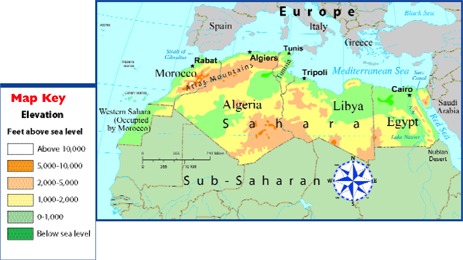 Physical Map of North Africa
Physical Map of North Africa
Egypt's location protected it from outsiders. There are deserts to the east and west. They were too big to cross. The Mediterranean Sea also kept enemies away. Ancient Egypt developed powerful dynasties, or rulers from the same family. The rulers were called pharaohs (fair-ohz), meaning “great house.” Egyptians believed that pharaohs were gods as well as kings. They owned all the land and commanded the armies. Egyptians also believed in life after death. When a wealthy Egyptian died, the body was wrapped in cloth. The wrapped body was called a mummy. Egyptians built magnificent pyramids, or tombs, for royal families. Dynasties ruled ancient Egypt for more than 2,500 years.
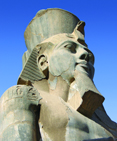 Statue of Ramses II, a pharaoh who ruled during the 19th Dynasty (1279-1212 BC).
Statue of Ramses II, a pharaoh who ruled during the 19th Dynasty (1279-1212 BC).
About 814 B.C., small Phoenician (fi-ni-shun) colonies along the Mediterranean Sea united into the powerful city of Carthage (kahr-thij) along the north coast of Africa. Phoenicians were great traders. They built many important seaports. Carthage became a rival of the Roman Empire. Roman armies finally destroyed the city. Over time, other invaders came from the eastern Mediterranean.
Ancient Saying: The Mediterranean Sea is a Phoenician lake. No man dares to wash his hands in it without Carthage's permission.
In A.D. 642, Arabs from Southwest Asia swept across North Africa. The Arabs brought Islam and the Arabic language to the region. This was an important change in culture. Under Muslim rule, cities became major centers of learning and trade. These cities included Cairo, Tunis, Algiers, and Fès. Arab laws and culture controlled the region for over a thousand years.
In the 1800s, European countries began to take over the region. Spain controlled northern Morocco and Western Sahara. France ruled the rest of Morocco, Tunisia, and Algeria. England governed Egypt. After World War II, some African countries gained independence. In 1962, Algeria was the last North African country to gain independence.
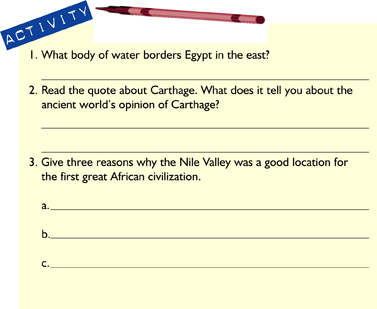
Who Are the People of North Africa?
For thousands of years, the Sahara Desert has separated the people of North Africa from the rest of the continent. North Africa developed a unique culture. Most of the people in North Africa are Arabs or Berbers. They have the same culture. The people practice the religion of Islam. Religion plays an important role in the people's everyday life. Muslims pray five times a day—at dawn, noon, afternoon, sunset, and evening. The newspaper even prints the times for prayer. The Muslim holy day is Friday. On Fridays, shops and banks are closed.
Most of the people in the region speak and write Arabic. In Egypt, nomads called Bedouins share the country with Egyptians and Berbers.
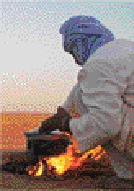 A Bedouin making dinner in the middle of the Egyptian desert
A Bedouin making dinner in the middle of the Egyptian desert
Family is very important in North Africa. It is also a part of their culture to welcome strangers. Visitors are invited to enter the tents of nomads. A peasant farmer may invite strangers to share a meal.
People in this region eat fruits and vegetables that grow in a dry climate. Couscous (koos-koos) is a favorite dish. It is made from wheat and looks like small bits of rice. Other treats include pickled lemons, chickpeas, eggplant, olives, and nuts.
Berbers are an ethnic group. They are Muslims, but they speak a Berber language. In Morocco, for example, most of the people are Berbers, not Arabs. Moroccan culture is a blend of Sub-Saharan, Arab, and European cultures.
Some Berbers are nomads. However, in most areas they are subsistence farmers. They raise just enough food to feed their families. When introduced to a Berber for the first time, it is their custom to kiss the visitor's hands and fingertips. This is a sign of respect. Once a year, Berber tribes get together for a big festival. A huge wedding is held and several couples are married. The couples wear special clothing, and the celebrations go on for several days.
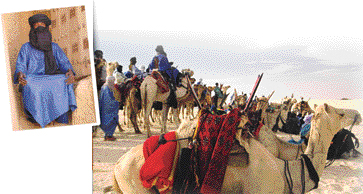 A Tuareg sitting inside the Loam Mosque of Timbuktu
A Tuareg sitting inside the Loam Mosque of Timbuktu
Tuaregs with their camels
The Sahrawis are nomads that live in Western Sahara. They are a mix of Arab and Berber people. The family clan forms the base of their society. The clan is the most important social group. After Morocco invaded the country in 1975, most of the Sahrawis became refugees. Refugees are people who leave their homes or country for safety. They often live in special refugee camps.
Arabs and Berbers live in the north of Algeria. An ethnic group called the Tuareg (twah-rehg) live in the south. The Tuareg are also nomads. They travel by camel caravans across the desert. They trade salt to earn a living. The Tuareg wear beautiful blue turbans.
North Africans celebrate Muslim holy days. They celebrate the birthday of Mohammed. Muslims also celebrate the holy month of Ramadan (rah-muh-dahn). During the month, Muslims avoid food and drink from sunrise to sunset. At the end of each day, families get together to eat. They drink pots of hot mint tea and share loaves of bread and fresh fruits.
The most important feast is the meal that ends Ramadan. It begins with soup or stew. The main dish is lamb or beef. Families that live close to the Mediterranean enjoy seafood. They serve a bowl of fresh fruit at the end of the meal. The fruit is peeled, sliced, and flavored with cinnamon and other spices.
Families eat meals around a low table. Food is eaten with the thumb, forefinger, and middle finger of the right hand. At school, lunch is often traditional foods, such as couscous, dried fruit, and sweet fruit drinks.
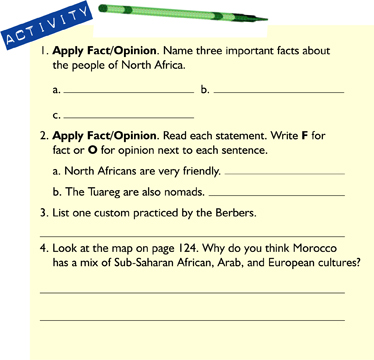
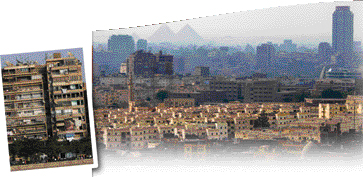 Skyscrapers along the Nile River, Cairo, Egypt
Skyscrapers along the Nile River, Cairo, Egypt
A view of Cairo with pyramids in the distance
What Is North Africa Like Today?
Most of the population in North Africa lives along the Mediterranean coast or in villages near the Atlas Mountains. In Egypt, however, the population lives along the Nile River and Nile Delta. Egypt has the largest population in North Africa. It does not have many natural resources. Most Egyptians are poor farmers. They do not have modern tools. People are crowded along the river and delta. There is not enough farmland to feed a growing population. Cairo, the capital, does not have enough room for housing. There are not enough jobs.
Many Egyptians must migrate to work in other countries. Migration is the movement of a large number of people from one place to live in another place.
During the time of ancient Rome, Tunisia was known as the African Province. It was the breadbasket of the Roman Empire. The country has rich farmland and busy seaports. Tunisia has one of the highest standards of living in the developing world. Tunis, the capital, has a population of about 700,000. It has modern buildings and is a rich trading center. The country has strong trade ties with Europe.
People in Southwest Asia call Western Libya, Tunisia, Algeria, and Morocco the Maghreb (muh-gruhb). Maghreb is the Arabic word for “west.” In this area, Berber, Arab, African, and Mediterranean cultures all mix together. Since much of the Maghreb is covered by the Sahara Desert, most cities and farmland are located in a narrow strip along the coast.
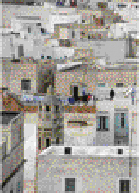 Section of the city of Tunis, Tunisia
Section of the city of Tunis, Tunisia
Oil is the most important natural resource in Libya and Algeria. The money from oil pays for schools, health care, and food. Their biggest trading partner is the European Union. In Egypt, the Suez Canal is important to the economy. The Suez Canal connects Europe and Asia, so ships do not have to make long trips around Southern Africa. Shipping companies pay about two billion dollars a year to pass through the canal.
The poorest territory in the region is Western Sahara. It is also the most sparsely populated country in the world. Most of the population lives in the city of El Aaiún (al ah-yoon). Both Morocco and the Sahrawis claim the land.
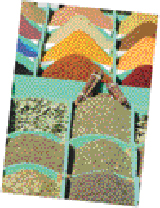 Colorful spices in an Egyptian souk
Colorful spices in an Egyptian souk
In many Arab cities, markets are located in the old walled parts of the city. Souks (sooks), or markets, sell food, spices, clothing, jewelry, and other goods. Souks attract tourists. In large cities in North Africa, tourism is an important part of the economy.
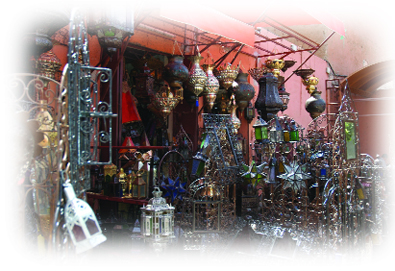 A souk in Marrakech, Morocco
A souk in Marrakech, Morocco
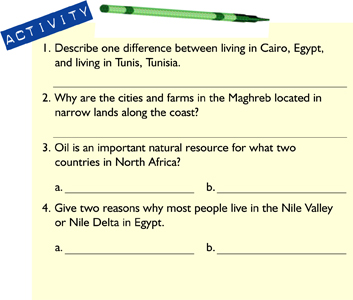
Additional topics
- How Has History Affected the People of Sub-Saharan Africa? - Who Are the People of Sub-Saharan Africa?
- What Is the Geography of Africa? - What Is the Climate Like?
- Other Free Encyclopedias
History Reference: Ancient History & World HistoryThe Eastern Hemisphere - Africa



